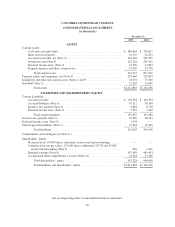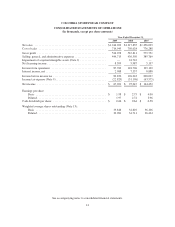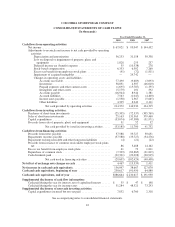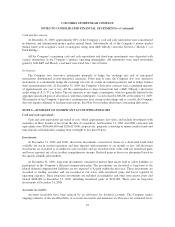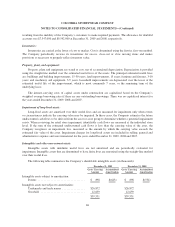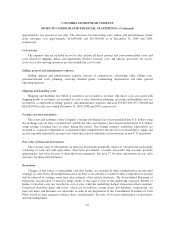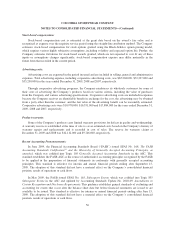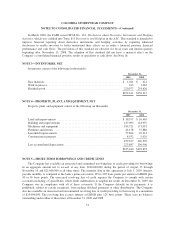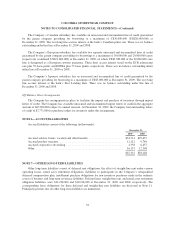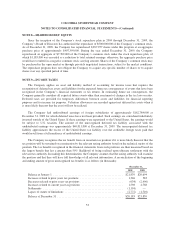Columbia Sportswear 2009 Annual Report Download - page 56
Download and view the complete annual report
Please find page 56 of the 2009 Columbia Sportswear annual report below. You can navigate through the pages in the report by either clicking on the pages listed below, or by using the keyword search tool below to find specific information within the annual report.COLUMBIA SPORTSWEAR COMPANY
NOTES TO CONSOLIDATED FINANCIAL STATEMENTS—(Continued)
approximately two percent of net sales. The allowance for outstanding sales returns and miscellaneous claims
from customers was approximately $13,889,000 and $10,583,000 as of December 31, 2009 and 2008,
respectively.
Cost of sales:
The expenses that are included in cost of sales include all direct product and conversion-related costs, and
costs related to shipping, duties and importation. Product warranty costs and specific provisions for excess,
close-out or slow moving inventory are also included in cost of sales.
Selling, general and administrative expense:
Selling, general and administrative expense consists of commissions, advertising, other selling costs,
personnel-related costs, planning, receiving finished goods, warehousing, depreciation and other general
operating expenses.
Shipping and handling costs:
Shipping and handling fees billed to customers are recorded as revenue. The direct costs associated with
shipping goods to customers are recorded as cost of sales. Inventory planning, receiving and handling costs are
recorded as a component of selling, general, and administrative expenses and were $55,867,000, $57,700,000 and
$64,420,000 for the years ended December 31, 2009, 2008 and 2007, respectively.
Foreign currency translation:
The assets and liabilities of the Company’s foreign subsidiaries have been translated into U.S. dollars using
the exchange rates in effect at period end, and the net sales and expenses have been translated into U.S. dollars
using average exchange rates in effect during the period. The foreign currency translation adjustments are
included as a separate component of accumulated other comprehensive income (loss) in shareholders’ equity and
are not currently adjusted for income taxes when they relate to indefinite net investments in non-U.S. operations.
Fair value of financial instruments:
The carrying value of substantially all financial instruments potentially subject to valuation risk (principally
consisting of cash and cash equivalents, short-term investments, accounts receivable and accounts payable)
approximates fair value because of their short-term maturities. See note 17 for more information on fair value
measures for financial instruments.
Derivatives:
Changes in fair values of outstanding cash flow hedges are recorded in other comprehensive income until
earnings are affected by the hedged transaction. In most cases amounts recorded in other comprehensive income
will be released to earnings some time after maturity of the related derivative. The Consolidated Statement of
Operations classification of effective hedge results is the same as that of the underlying exposure. Results of
hedges of product costs are recorded in cost of sales when the underlying hedged transaction affects earnings.
Unrealized derivative gains and losses, which are recorded in current assets and liabilities, respectively, are
non-cash items and therefore are taken into account in the preparation of the Consolidated Statement of Cash
Flows based on their respective balance sheet classifications. See note 16 for more information on derivatives
and risk management.
49



